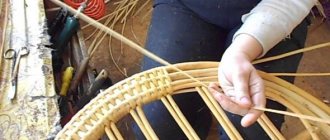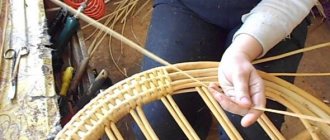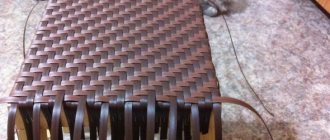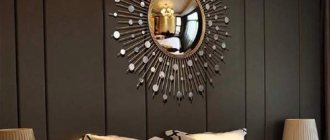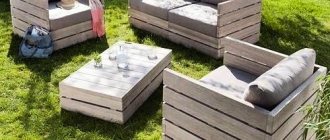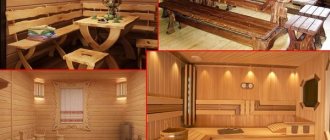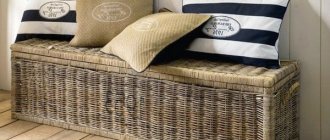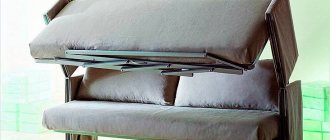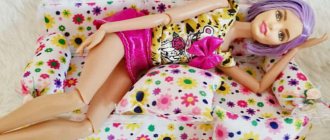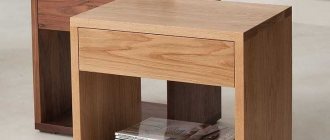Recently, furniture made from natural materials has become increasingly popular. It is beautiful, environmentally friendly, has a special warmth, is durable, does not cause allergic reactions, and creates a special atmosphere of coziness and comfort. Wicker products occupy a special place in the furniture market. But furniture made independently is considered a special chic and source of pride.
It is beautiful, environmentally friendly, has a special warmth, is durable, does not cause allergic reactions, and creates a special atmosphere of coziness and comfort.
The benefits of making furniture with your own hands
Made with your own hands, such furniture has advantages and certain disadvantages. Among the undeniable advantages:
- light weight, allowing you to move it to any place in the room or area of the site;
- does not require special care: it looks elegant and fresh, if you periodically wipe it with a damp cloth or sponge, this simple procedure protects the product from cracking;
- fits perfectly into any interior, adding lightness and sophistication;
- environmentally friendly, not emitting substances harmful to health into the surrounding atmosphere;
- when weaving is done correctly, it is durable and strong;
- complete freedom of imagination for home craftsmen;
- will significantly save the family budget;
- the opportunity to acquire skills that allow you to organize your own small profitable business.
Made with your own hands, such furniture has advantages and certain disadvantages.
Despite the undoubted advantages of wicker furniture, there are also disadvantages that must be taken into account:
- afraid of high humidity: cannot be left outdoors in bad weather;
- At the same time, the scorching sun will also not do any good: the furniture will dry out, warp, and lose its appearance, which will lead to a reduction in service life.
Light weight, allowing you to move it to any place in the room or area of the site.
Furniture and interior items
0 votes
+
Vote for!
—
Vote against!
Do-it-yourself wicker furniture for a summer cottage will never go out of fashion - these are exclusive products for an elite interior. The first time it may not turn out as in the illustration, and you need to learn this, like any other technology. It is better to start small and practice on the simplest materials, such as rolled newspapers that are woven around old chairs. Weaving a whole set of furniture with your own hands is not only a fascinating process, but a reason to be proud of your friends, and also a good idea for business.
Table of contents:
- Types of wicker furniture
- Advantages and disadvantages of wicker country furniture
- Materials for making wicker furniture
- Features of the procurement of raw materials for “braiding”
- DIY wicker chair
- Is Braiding a Hobby or a Business?
Types of wicker furniture
Beautiful wicker furniture in the interior of a country house looks like an elite accent for furnishing an open terrace or veranda. And a ready-made set of rattan and wicker is not available to all families, so more and more enthusiasts are mastering this technique. There is a noticeable trend in the growing number of craftsmen who are ready to do everything in an apartment and in a country house with their own hands - from the foundation of a building to a homemade pool and furniture.
If the hands are skilled and the taste is artistic, then simple things turn into masterpieces. The main thing is to master any technology step by step and choose successful illustrations for inspiration, like this wicker furniture made of artificial rattan.
Original products, made very carefully, will become a worthy decoration for any summer cottage. The material used for weaving is what grows literally a stone's throw from the house. All that remains is to prepare the material and choose which sample to start mastering the weaving technique with:
- rocking chair;
- set of chairs;
- coffee table or cabinet;
- small sofa;
- chair;
- stands for flowers and other interior items.
The easiest way to master weaving is on small samples - baskets or bread bins. Gradually, interesting patterns will begin to emerge, which have been used by folk craftsmen since ancient times. Historians claim that the first examples, reminiscent of low wicker stools, were offered by artisans during the Roman Empire and Antiquity. But they were used by poor people and traders, since cheap “seats” without a back were light, comfortable and mobile.
After “plebeian” models began to be made more skillfully, representatives of noble families began to buy the most elegant examples of wicker furniture. The growth in popularity was also facilitated by the fact that they were made much faster than wooden furniture and required fewer tools. Over time, in the houses of medieval Europe, both classical samples and independently wicker furniture made of wicker coexisted.
With the development of woodworking machines, homemade “wicker” began to be abandoned, but the fashion for it periodically returns. And today, at the peak of popularity, garden furniture for cottages made of wicker, rattan and other natural materials that are available in the natural environment. They even use twine, old newspapers and corn leaves, especially for the openwork weaving of homemade furniture inserts on a rigid wood frame.
Today, the availability of materials and design features of the preferred type of seat determine the technology for manufacturing samples of wicker garden furniture. There are frameless products and braiding of finished furniture, where they use:
- openwork and solid;
- single and double;
- continuous and combined weaving.
The more different techniques are combined in one product, the more original and beautiful the sample looks. But a real masterpiece comes out provided that the patterns are carefully executed, the ends are properly designed and proportions are observed. Today craftsmen make the following types of wicker furniture for the garden:
1. Frame models on a durable base, where wood, metal rod, plastic or other durable material is braided.
2. Frameless models using reliable stiffeners.
3. With wooden frame for reliability and stability.
4. Braiding finished products with natural materials.
5. Stacked carpentry-frame furniture with steel rods braided with vines and filling the space with openwork patterns.
6. Stick or structure, where vertical hard stems form load-bearing walls braided with softer materials.
Please note: Original wicker furniture is found in the interiors of expensive hotels and bungalows; it often decorates the landscape design of the estate of a wealthy European family. Such samples are not considered “homemade”; they are rightfully classified as elite garden furniture. They remain the best role models for folk craftsmen and beginners in weaving.
Advantages and disadvantages of wicker country furniture
Homemade furniture is a source of pride for a home craftsman. And although it takes a lot of time to procure material and manufacture products, the demand for “braid” is increasing.
Wicker furniture has a number of undeniable advantages:
- low cost;
- environmentally friendly models;
- large design variability;
- the possibility of making a seat “to suit yourself” and the preferences of the family;
- light weight (easy to carry around the garden);
- not afraid of high air humidity and steam;
- ease of care and operation (wipe with a damp sponge);
- self-sufficient decoration of a dacha, open veranda or open area.
Obvious disadvantages are susceptibility to changes in mass, the “braid” cracks and gets wet from the rain.
Materials for making wicker furniture
Plants with flexible stems and branches are found in most regions of the world, and natural twigs from their area are preferable. In some places, homemade furniture is woven from plant leaves and seaweed, which are used to braid a synthetic rope base. In Asia and Africa they use:
- young bamboo;
- sorghum (millet);
- cane;
- water hyacinth;
- banana leaves (abaca);
- palm branches;
- rattan and other varieties of vines.
To make wicker furniture for a summer house, long flexible sprouts are suitable, which can be easily split into long fibers and the bark removed. Softer openwork inserts can be easily made from jute rope entwined with corn leaves. In Eastern Europe, craftsmen prefer:
- willow;
- cattail;
- reed;
- alder;
- bird cherry;
- krasnotal (verbolosis);
- raspberry and blackberry stems;
- hazel and other flexible stems of trees and shrubs that are easy to find in your region.
Alternatively, it is easier to weave from prepared materials, which are ordered through specialized handicraft catalogs, but this is expensive. Ready-made sets of garden furniture are often made from a synthetic analogue of natural vines - artificial rattan. As an ornamental material for beginners, tubes from old newspapers are used, which are used to braid stools and old chairs that have lost their appearance.
Flexible branches and stems are cleared of bark or split into fibers. When boiled in a salt solution or treated with steam, the properties of the natural material change - it becomes more durable and elastic.
The rattan vine is considered the most amenable to processing, the stems of which remain thick for many meters. It is considered the most wear-resistant, is not afraid of moisture and is excellent for furniture frames - it is the most commonly used material for making furniture. This is the most suitable material for luxury garden furniture.
The name "rattan" comes from the British surname Rattan - planters who brought from Indonesia samples of wicker furniture and multi-meter vines for its manufacture. Today, for rattan wicker furniture, vines can be ordered or purchased in bulk.
Thinner stems from their region are often tied into bundles for strength, intertwined with natural and synthetic materials. But the good taste of the craftsman is important here, so that the legs or back of the product do not look like the handle of a broom or broom.
Attention: Homemade furniture must be durable and safe, supporting the weight of a seated person behind the bench. Metal rods and strong ties will increase its reliability.
The main load on the product is borne by units and joints (detachable and solid). When making wicker furniture, detachable units simplify assembly, but it is from them that the destruction of the entire structure gradually begins. The monolithic frame is bent using a rattan template after heat treatment, and this is a complex technological process. The so-called “Viennese” chairs, which last more than 100 years and do not break when dropped, are made using exactly this technology.
Features of the procurement of raw materials for “braiding”
The most suitable time for harvesting twigs is considered to be autumn, when trees and shrubs shed their leaves and the buds have not yet formed. The rod is cut at an angle of 45°, and the bark is removed later. The raw material is stored dry for a long time, and to increase elasticity it is boiled before use.
For openwork patterns on the backs, seats and sides of wicker furniture, use a thinner rod prepared in the spring.
It is preferable to cut thin rods for openwork weaving in the spring - during sap flow, but before the leaves bloom.
Tip: When cutting stems and branches, preference is given to the most plastic fragments of the plant that do not break when bent.
The more the bark-cleaned twig is boiled, the lighter or darker it becomes, depending on the raw material. This is done in large containers under a lid, lowering the temperature after the water or solution boils.
Some plants are boiled with their bark to produce a darker color. Dark bark, split off from a rod with fibers after boiling, is often used for cross strapping of some of the structural parts of wicker furniture.
After preparing the raw materials, choosing the furniture design and weaving patterns, you can proceed directly to manufacturing. To do this you will need templates, weaving patterns and simple tools. These are pruning shears and sharp knives, a saw and a tape measure, as well as a pencil, chalk or marker for marking.
DIY wicker chair
Wicker chair designs:
- legs;
- backrests;
- sitting;
- sidewalls with handrails;
- drawers and legs (crossbars between legs);
- decorative elements.
The supporting frame of a homemade wicker chair largely replicates the elements of a stool or chair, but you can also make a rocking chair with a footrest.
The back of the chair and the rear legs are formed on a single base, and it is better if it is a solid element, but there may be options with an upper crossbar. If it is not rattan, but separate rods, you need to insert a metal base inside and braid it.
Important: Make sure that all legs are symmetrical, and maintain the angle of inclination in pairs if it differs between the front and rear legs!
The frame must be made of the thickest and strongest parts, and a flexible braid is needed when joining the fragments.
The seat will be made of strong rods - solid or openwork, circular weaving or rectangular. The ends are attached directly to the drawers.
Armrests are mandatory elements of a chair and a decorative addition. However, wide armrests not only provide a comfortable posture while relaxing, but also give the wicker chair additional strength. The best option is when the handrails go into the back of the chair in a single continuous line, as in the examples of do-it-yourself wicker furniture.
Tip: The rods must be longer than the structural parts according to the template in order to make a hidden bend at the ends.
After completing the main work of assembling and braiding the base, small rods are fixed into the gaps and decorative elements are completed.
Is Braiding a Hobby or a Business?
Homemade furniture made from wicker or willow twigs is an elegant decoration for a summer house. Attractive appearance and reliability are what can impress your loved ones, and they can place your first orders. If everything turns out very carefully, and the process of creating wicker furniture itself seems very exciting, then it can grow from a hobby into a real profitable business. To improve your craft, each new design must include new designs and patterns.
When making wicker furniture using ready-made samples, it is easy to create an aesthetic model from environmentally friendly materials. However, a beginner should not immediately take on complex masterpieces made by experienced craftsmen or proposed by designers of luxury rattan furniture. The unusual look of homemade garden furniture will be provided by the technique of weaving from wicker. If you have any questions or doubts, we recommend this video:
Deciding on design and construction
Structurally, wicker furniture can be:
- frameless,
- frame.
Fits perfectly into any interior, adding lightness and sophistication.
For a frameless structure, it is enough to use sticks. They perform the function of hard ribs. The difference between frame products is the presence of a metal base; steel rods are used for it. The weaving seems to be “attached” to them. Wooden poles provide stability and rigidity to the wooden structure.
Does not require special care: it looks elegant and fresh if you periodically wipe it with a damp cloth or sponge.
If home craftsmen are taking their first steps in weaving furniture, they should not take on complex products: it will be extremely difficult for an inexperienced craftsman to complete them, which will lead to numerous mistakes and disappointments; you need to start with the simplest ones, which give you the opportunity to master the necessary skills.
In order for the product to be of high quality and durable, you need to properly prepare the raw materials.
The furniture has several types of weaving:
| Type of weaving | Distinctive features |
| Single | Simple weaving is easy to master: each branch alternately braids all the posts of the frame. Usually used as the main method of making wicker items. Gives additional strength and keeps the shape of the product. |
| Openwork | Weaving is used in furniture decoration, adding special chic and originality. It can be used to create waves, corners, ovals, crosses, and diamonds. Requires perseverance, attention, accuracy. Before execution, you need to decide on the ornament, weave several single rows, then choose a decoration method. The most commonly used is straight openwork with stripes of light. A fairly complex type of work that requires significant skills. |
| Combined | This type is a combination of single and openwork weaving in their varieties. The design of wicker products using combined weaving is “aerobatics” and indicates a high level of craftsmanship. |
Environmentally friendly, does not emit substances harmful to health into the surrounding atmosphere.
Caring for wicker and rattan products
Wicker furniture requires special care, which is due to the characteristics of the material used: wicker and rattan can become very fragile if not used correctly.
- At least once a week, wipe off dust from products with a damp cloth.
- If a large amount of water gets on wicker furniture, first wipe thoroughly with a dry cloth, then take it out into the air to allow the product to dry naturally. Do this immediately.
- Vacuum wicker items only using soft attachments.
- If you notice that the braid has begun to dry out, spray it with linseed oil from a spray bottle.
- To protect wicker furniture from moisture, treat it with tung oil or tung-based products twice a year. Do this at the beginning of the season (before moving furniture outside) and at the end.
To protect wicker furniture from high humidity, treat it with tung oil-based products.
Wicker furniture is a rather difficult product to repair. In the event of a breakdown, it is difficult to find a repairman who will undertake the repair. Therefore, proper care is mandatory and necessary for products made from wicker and rattan.
Necessary materials
To make furniture from wicker you will need materials. It is worth noting that they can be different, and many are exotic and inaccessible to us: banana leaves, bamboo, water hyacinth, seaweed. But most of the furniture is made from rattan, willow twigs, bird cherry vines, alder, raspberry, and hazel.
Experts say that it is possible to harvest raw materials in the spring.
IMPORTANT! If you decide to use a vine, willow and bird cherry, which are particularly flexible and plastic, are best suited. Bird cherry is especially good in this regard.
When weaving correctly, it is durable and strong.
Excellent decorative elements are colored pillows and blankets of various colors.
Preparation of raw materials for robots
In order for the product to be of high quality and durable, you need to properly prepare the raw materials. Most often these are willow twigs.
- For weaving, you can harvest material that is collected from living trees in the absence of buds; the most suitable time for harvesting is late autumn. You need to make it before the first frost - such raw materials are easy to clean and store dry.
- Experts say that you can prepare raw materials in the spring, but you need to remember that you need to cut the rods before the buds begin to swell; if you are late, green leaves will appear on the new furniture.
- You need to cut the branches at forty degrees - pruning will not harm the tree, and in a year or two new branches will appear.
- You need to conduct a kind of flexibility test. The cut branch must be bent: if it does not break, then the raw material is suitable for the job. Thin vine used for fine binding of products is considered to be of high quality.
- Thicker branches are used to make the frame.
The opportunity to acquire skills that allow you to organize your own small profitable business.
Difficulties of self-production
The technology of assembling frames and weaving is not particularly difficult in itself. Of course, there are very attractive products made in different techniques and which are, in fact, works of art. However, a novice user can try his hand at simpler products to gradually increase his skill.
Moving from simple to complex products, you can gain experience and develop the necessary skills, learn some subtleties and, as they say, get better at it.
The main difficulty should be considered not the manufacturing process itself, but the procurement of material. If you decide to work in a traditional technique (with willow vine), you will have to spend a lot of time preparing, drying, storing and then soaking the twigs. In addition, you will need to acquire special tools and devices for cutting thin strips, removing bark, etc.
If you don’t have the time or opportunity to do this, you can simply buy artificial rattan and materials for making frames. Then all the work will consist of making furniture, and preparation will be reduced to a minimum.
Required Tools
To weave furniture from wicker, you don’t need many tools, but you should have:
- knives and pruners;
- tape measure and measuring tape;
- various templates.
Afraid of high humidity: should not be left outdoors in bad weather.
We must not forget about the armrests, which, however, are made at the request of the master, but serve as an additional element to strengthen the entire structure.
This is the required minimum; with the help of such a set of tools you can weave simple and small-sized products.
The difference between frame products is the presence of a metal base; steel rods are used for it.
Types of weaving for beginners. Description and features
Vine weaving (for beginners it is important to learn each type of weaving separately), as a rule, is done from left to right, that is, the working vine always remains on the left.
There are several types of weaving:
- in 2 rods;
- in 3 rods;
- weaving in layers.
The method where 2 rods are used at once is one of the simplest to perform. In the finished product, the vine not only entwines the frame, but also intertwines with each other. The products are strong and reliable.
Wicker weaving pattern for beginners.
Weaving from 3 rods is a little more complicated. It is used for the manufacture of particularly durable objects, and also makes transitions between horizontal and vertical parts of the product.
Layer weaving resembles regular weaving, but the direction of the rods is different. They should look up diagonally and be positioned at an angle of 10-15 degrees. The stronger the slope, the higher the weaving layer. New rods are inserted to the left of the previous ones, then weaved between the base of the frame. The branches are alternated and laid so that the weaving is beautiful outside and inside.
Manufacturing process: technology and manufacturing nuances
In order not to lose interest in weaving furniture and not to spoil a large amount of material, you should not immediately “swing” at large and quite complex products - a sofa or a table. It’s better to start with the simplest “braids”, for example, a chair. It consists of several elements: a lower bench, a seat, a backrest, and armrests. To work, you will need willow sticks with a diameter of up to 30 mm and thin willow twigs.
Wooden poles provide stability and rigidity to the wooden structure.
The beginning of the work is the manufacture of the frame.
ADVICE. When working on a chair, you will need curved parts. To bend the rods, you need to soak them, and when they become soft, remove any irregularities and bend them on a prepared template and let them dry.
You need to cut the branches at forty degrees - pruning will not harm the tree, and in a year or two new branches will appear.
The beginning of the work is the manufacture of the frame. If a craftsman is taking his first steps in weaving furniture, it is better to use the frame of an old chair made of metal or wood to make the work easier.
You need to conduct a kind of flexibility test.
When working on a chair, you will need curved parts.
ATTENTION! We must not forget about the armrests, which, however, are made at the request of the master, but serve as an additional element to strengthen the entire structure.
But most of the furniture is made from rattan, willow twigs, bird cherry vines, alder, raspberry, and hazel.
The procedure for making a chair.
- We make the frame. The frame itself is made of thick, durable sticks and a piece of plywood, which is used as a seat. One pair of sticks will act as the front legs; it should be 15-20 cm shorter than the second.
- The legs are connected with self-tapping screws, the seat is nailed down.
- Also, the curved elements of the chair back and armrests are attached to the frame with self-tapping screws.
- The frame is wrapped with willow ribbons and can be secured with glue for strength.
- The frame is braided using single weaving.
Bird cherry is especially good in this regard.
It’s better to start with the simplest “braids”, for example, a chair.
If desired, the resulting chair is treated with stain.
To make furniture from wicker you will need materials.
Finishing wicker furniture
When a chair, table, sofa or other item is ready, all that remains is to give the item a marketable appearance. Finishing work is carried out in several stages:
- Inspection for various defects, eliminating them: correct the uneven density of the weaving by slightly moving the rods, align the legs, cut off the tips of the rods and smooth out the unevenness with fine-grained sandpaper.
- Bleaching and painting. To make the product white, it is treated with lime or sulfur dioxide. To give a different color, use regular paint. They also use decoctions of onion peels, wolf berries, heather, alder bark or moss, if you like naturalness and environmental friendliness.
- Varnish coating. In order not only to preserve the texture of the material used, but also to make it even stronger, apply 2-3 layers of varnish (each subsequent after the previous one has completely dried).
The final stage is decoration
High-quality wicker furniture practically does not need decoration: it is good in itself. If you want to add an element of creativity and “revive” it with bright colors, you can use willow ribbons in weaving, including dyed ones; they will be organically combined in the ornament of the product. Excellent decorative elements are colored pillows and blankets of various colors.
If home craftsmen are taking their first steps in weaving furniture, they should not take on complex products.
Thicker branches are used to make the frame.
Peculiarities
The main feature of wicker furniture is its integrity. Each product is a single piece of furniture that cannot be disassembled without losing its working properties. In addition, wicker furniture lacks upholstery, soft elements and exposed wood parts.
Armchairs and sofas can have a curvy shape that looks like furniture with a thick soft layer. However, this is just an imitation. The surface of wicker products is a continuous fabric of interwoven linear elements. They are quite rigid, therefore, for comfortable use, pillows are often placed on the seats and backs.
Today, the assortment of retail chains includes very attractive examples of upholstered and cabinet furniture made from linear elements. Using flexible metal and plastic tubes for the frame, you can give the products any shape. This allows us to produce original pieces of furniture with a high decorative effect. But their cost is very high, which significantly limits demand.
Making wicker furniture is 90% handmade. It is extremely difficult to mechanize it; it is much easier to work the old fashioned way. However, the productivity of small factories fully covers demand. The fashion for wicker furniture has long passed, and for lovers of the exotic, the assortment of specialized stores is quite sufficient.
